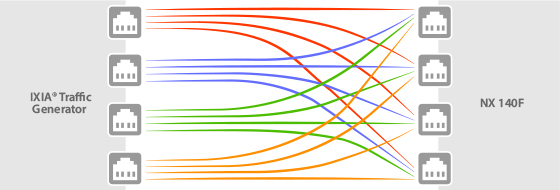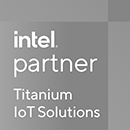NSA 7150 Brings Scalability and Improved Performance with 3rd Gen Intel® Xeon® Processors
Trend
With extreme speed and economy of scale, global pandemic pushes 5G technology from small POC try-outs by telco operators, to large deployment in the fields, especially within dense urban areas. The so-called ‘New Norm’ way of life, is when people spend extensive time working from home, online meeting, schooling, shopping, gaming, dating, streaming, surfing, and even mining; these activities have led to a burst of data traffic volume over IT network highways. However, digital highways are far from perfect, as jams occur at bottlenecks, rush hours and off-peak times happen daily. Access control, safety concerns, and chasing traffic violators, are familiar sounding chores not only for the highway patrol officers on Interstate 5 in California, but also stand true for IT support professionals during their daily routines.

Now 5G introduces a new dimension to the IT infrastructure. DSS (Dynamic Spectrum Sharing) is a key innovation of antenna technology that paves the way for a smooth migration from 4G LTE to 5G NR network. Non-standalone (NSA) 5G NR mode allows 5G to run under the same frequency range as 4G LTE, thus accelerating the rollout of 5G while operating under a matured existing LTE network infrastructure.
Another essential part of 5G system is mmWave (FR2), which allows greater bandwidth (30 to 300 GHz), making enhanced Mobile Broadband possible. It introduces performance benefits that create new monetization opportunities for all companies in the IT industry.
ORAN (Open Radio Access Network) became one of major focuses as its open standards invite multi-vendor business model into the market where traditional RAN players have dominated for decades. 5G introduces a new dimension to the IT infrastructure. ORAN creates entrance point for managed services providers, giving them the opportunity to partner up with different solution vendors to offer equipment and software features that best suit customers needs, unlike single RAN vendors which are stuck with proprietary equipment and vendor lock-in software.
Challenge
The movement of open architecture in a distributed IT network, similar to the ORAN mentioned above, has its own challenges to address. For instance, while operators are opting for new revenue streams from the highly-acclaimed 5G network slicing under NFV (Network Function Virtualization) framework, they face resource sharing issue across slice tenants. Ideally, dynamic resource sharing can be achieved as opposed to static partition sharing, since it results in the most efficient utilization of resource. However, it calls for sophisticatedly good radio scheduling mechanism to allocate resources to each slice. In addition, isolation between slices can be complicated, it may be implemented either via data plane isolation or via control plane isolation, the latter usually set for control among slices. For missioncritical tasks of a specific set of services that require highest level of slice isolation, the slice isolation mechanism is rather crucial, or a security issue may arise.
Cases above demonstrate the complexity of recent application scenarios handled by service providers. With adoption of new technology, new and tricky issues emerge for us to overcome.
Solution
To tackle these challenges, NEXCOM has developed the NSA 7150, a 2U highperformance rackmount, fully equipped 3 NEXCOM White Paper with the latest technologies and powered by dual 3rd Gen Intel® Xeon® Scalable processor. The NSA 7150 can be deployed in various settings, thus, opening up more opportunities for CommSPs. Performance of the NSA 7150 is significantly improved when compared with its predecessor, the NSA 7146; where the previous generation of the same processor family has been used. Both appliances feature built-in acceleration, Intel® QuickAssist Technology (Intel® QAT) for optimal resource allocation, enhanced security and are optimized for many workload types.
3rd Gen Intel® Xeon® Scalable processors support up to 40 cores, which is beneficial for its overall performance. Another noticeable enhancement over its predecessor would be the significantly increased memory capabilities. NSA 7150 leverages this advantage to achieve a maximum connectivity of 1.2 Tb, while also supporting Intel® Optane™ Persistent Memory for larger capacity and data persistence.
In regards to networking, the NSA 7150 offers imposing expansion capabilities. With eight expansion slots, it is able to host a variety of LAN modules or expansion cards. NEXCOM’s versatile portfolio offers various LAN modules ranging in different form factors, port types and speeds from 1GbE to 200GbE. The wireless adaptor, NSK 6301 can be installed to enable wireless connectivity, offering 4G LTE, 5G and Wi-Fi 5/6, while providing the flexibility to rackmount network appliances as a secondary wireless WAN route.
To offer more peace of mind, the NSA 7150 can be coupled with Ethernet bypass LAN modules to ensure a higher level of security for 5G-core network or a backup measure for high availability. In case of unfortunate events where the HPC server crashes or a cyberattack is identified, the 100G bypass LAN module can block unwanted Ethernet traffic from entering the Intranet to protect sensitive data and forward unwanted traffic to the other HPC server to maintain network functionality. Firmware failover mechanism is ensured through the implementation of Dual BIOS.
In terms of management, optional RunBMC module can be installed for out-of-band (OOB) management enabling. In addition, the health status of system components is easily accessible through the browser, and the KVM functions support remote system console viewing, allowing administrators to react promptly when the system fails without having to enter server room.
To compare the throughput performance of the two generations, we put NSA 7150 through a benchmark test, head-to-head with its predecessor—NSA 7146. The same 10GbE LAN module—NX 140F—was fitted into both of these appliances; with data flowing from IXIA® Traffic Generator through 10GbE LAN module, to NSA 7150/NSA 7146, to the test app and back. Moreover, to put the appliances under maximum loading, full mesh topology has been chosen for the throughput test. Example of full mesh topology for a LAN module with 4 ports is shown in Figure 1.

Figure 1. Example of full mesh topology for Ethernet throughput test.
Both appliances were tested with different sizes of packets (from 64 to 1518 bytes), NSA 7150 clearly outperforms NSA 7146 with higher packet delivery ratios in most conditions. The results are shown in Figure 2.
-and-NSA-7146-(orange).jpg)
Figure 2. Test results comparing throughput for NSA 7150 (blue) and NSA 7146 (orange).
To put throughput performance of the NSA 7150 in more context, a Data Plane Development Kit (DPDK) test was held, with two 100GbE LAN modules — NC 120FIS4-OS — for two-way traffic. DPDK, which can improve packetprocessing performance by up to ten times, is used to boost packet processing performance and throughput, allowing more time for data plane applications.

Figure 3. Throughput test setup for NSA 7150 with and without DPDK enabled.
Testing results shows that the NSA 7150 performs significantly better in test with DPDK in comparison with Direct IRQ (without DPDK), as shown in Figure 4.
-and-with--DPDK-(blue)-enabled.jpg)
Figure 4. Test results comparing throughput for NSA 7150 without DPDK (orange) and with DPDK (blue) enabled.
Conducted tests verify that the latest generation appliance achieves better results in Ethernet throughput performance. Compared to its predecessor, the NSA 7150 outperformed NSA 7146 by approximately double in terms of packets delivery ratio during throughput test of 64-256 bytes packet traffic. Lastly, a further throughput performance improvement with DPDK shows the NSA 7150 with DPDK enabled reached 100% data throughput already on 128 byte-sized data transfer.
Conclusion
Besides 5G applications which come in all sorts of shapes and sizes, the requirements of network infrastructure also differ accordingly. In today’s highly technology dependent society, the demand for scalable networking appliance continues to increase significantly as they are applied to more and more IT scenarios and use cases. This is where NEXCOM’s NSA 7150, a flexible high-performance 2U rackmount comes in. It is an appliance that meets a wide range of requirements, fulfills demand without overspending, making it the optimal appliance for deployments in new or existing network infrastructure. NSA 7150 equipped with Intel’s latest technology, offers users excellent features that undoubtedly achieves the leading performance in today’s industry.

- Related Links:
- Achieve Faster AI Insights with NEXCOM FTA 5190 and Xeon® 6 SoC
- NEXCOM Drives Edge AI, Dual 5G, and OT Security Innovation at CommunicAsia 2025
- Browse Other News:
- Urban PET Recycling Reinvented Sustainable Solutions Powered by NDiS B561
- AIEdge-X®80 Leaps Ahead: Power Up TOPS Performance with NVIDIA® Jetson™ Super Mode
- All White Papers News

